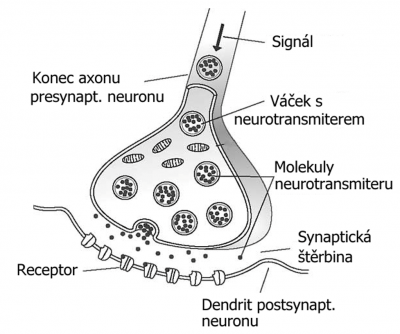Interesting facts from the world of organic chemistry
Derivatives - organic nitrogen compounds:
Acetylcholine
Acetylcholine is an ester of choline and acetic (ethanoic) acid. It is a white crystalline substance that is well soluble in water. It is a neurotransmitter found in the central and peripheral nervous systems of humans and other animals. It is also one of the oldest known neurotransmitters, having been discovered as early as 1914.

Picture above: Chemical structure of acetylcholine molecule.
Importance of acetylcholine
Acetylcholine is one of the most important neurotransmitters in the human body and plays a role in many different functions, including:
• Cognitive function: Acetylcholine is essential for learning, memory and attention.
• Motor function: Acetylcholine is responsible for controlling muscle contraction as it transmits impulses from nerves to muscles.
• Autonomic function: Acetylcholine regulates heart rate, blood pressure, digestion and other autonomic functions.
Within the peripheral nervous system, acetylcholine is one of a number of neurotransmitters in the autonomic system. However, it is the only neurotransmitter in the somatic system (the somatic nervous system controls skeletal muscles and directs active movement).

Picture above: Transmission of nerve impulse by acetylcholine.
Acetylcholine transmits nerve impulses between presynaptic parasympathetic and sympathetic fibers and postsynaptic parasympathetic fibers as shown in the figure below. In the central nervous system, it is precisely acetylcholine that controls the secretion of the entire spectrum of other neurotransmitters. These include dopamine, glycine and glutamate. The role of acetylcholine is irreplaceable among neurotransmitters. If the acetylcholine pathways in the brain were to malfunction, a complete disintegration of the personality could occur with all the associated consequences.
Synthesis and degradation of acetylcholine
Acetylcholine is synthesized in cholinergic neurons from choline and acetyl-CoA. Choline is obtained from food or synthesized in the liver. Acetyl-CoA is synthesized in mitochondria.
Acetylcholine is released from cholinergic neurons into the synaptic cleft. There it binds to acetylcholine receptors on postsynaptic neurons. Activation of acetylcholine receptors produces different effects, depending on the type of receptor.
Acetylcholine is rapidly degraded by acetylcholinesterase. Acetylcholinesterase is an enzyme that breaks down acetylcholine into acetyl-CoA and choline.
Acetylcholine is synthesized in the body of animals and humans by the reaction of acetyl coenzyme A and choline catalyzed by choline acetyltransferase (cha-1):

Picture above: Biosynthesis of acetylcholine in animal bodies.
Effects of acetylcholine in the brain
In the brain, acetylcholine is responsible for many different functions, including:
· Cognitive function: Acetylcholine is essential for learning, memory and attention.
· Emotional function: Acetylcholine plays a role in emotions such as fear and anxiety.
· Sleep and wakefulness: Acetylcholine regulates the sleep-wake cycle.
Transport
Acetylcholine is transported to synaptic vesicles, where it is stored until it is released into the synaptic cleft.
Effects
Acetylcholine acts on two types of receptors: nicotinic and muscarinic. Nicotinic receptors are ionotropic receptors that open ion channels, causing depolarization of the postsynaptic cell. Muscarinic receptors are metabotropic receptors that activate signaling cascades that lead to various effects such as changing ion channel permeability, protein phosphorylation, and gene synthesis.
Acetylcholine disorders
Acetylcholine disorders can cause a number of health problems, including:
· Alzheimer’s disease: Alzheimer’s disease is a neurodegenerative disease that is characterized by the loss of acetylcholine in the brain.
· Parkinson’s disease: Parkinson’s disease is a neurodegenerative disease that is characterized by a lack of dopamine in the brain. However, dopaminergic neurons are also cholinergic, meaning they use acetylcholine.
· Myasthenia gravis: Myasthenia gravis is an autoimmune disease that causes muscle weakness. Acetylcholine is important for muscle contraction, so its deficiency can lead to muscle weakness.
An increase in the level of acetylcholine
Acetylcholine levels can be increased in several ways, including:
· Diet: Certain foods and supplements can help increase acetylcholine levels, such as nuts, seeds, green leafy vegetables, and choline supplements.
· Exercise: Exercise can help increase acetylcholine levels in the brain.
· Therapy: There are some types of therapy that can help improve cognitive function and increase acetylcholine levels, such as cognitive-behavioral therapy and cognitive stimulation therapy.
Conclusion
Acetylcholine is an important neurotransmitter that plays a role in many different functions in the brain and body. Acetylcholine disorders can have serious consequences. There are several ways to increase acetylcholine levels, including diet, exercise, stress reduction, and possibly treatment.
Sources:
[1] L. Polák, „U psychiatra.cz,“ 14 9 2012. [Online]. Available: http://www.upsychiatra.cz/srozumitelne/neurony-neurotransmitery-a-synapse/. [Přístup získán 8 6 2013].
[2] C. Loer, „Neurotransmitters in Caenorhabditis elegans, in WormAtlas.,“ 2010. [Online]. Available: http://www.wormatlas.org/neurotransmitterstable.htm. [Přístup získán 8 6 2013].
